Education > QUESTIONS & ANSWERS > [Solved] Walden University NURS 6521 Week 11 Quiz (All)
[Solved] Walden University NURS 6521 Week 11 Quiz
Document Content and Description Below
Walden University NURS 6521 Week 11 Quiz · Question 1 1 out of 1 points A nurse is explaining to the parents of a 6-year-old child suffering from angina why nitroglycerin patches for... chest pain would not be appropriate. Which of the following will the nurse include in an explanation? · Question 2 1 out of 1 points An immunocompromised 7-year-old child was recently discharged home with a peripherally-inserted central line (PIC line) for home antibiotic therapy. He has now been brought to the emergency department by his mother and father with signs and symptoms of line sepsis. Upon questioning, the mother states that she has been removing the PIC dressing daily and washing the site with warm water and a cloth. What nursing diagnosis is most appropriate in this situation? · Question 3 1 out of 1 points A nurse working in a cancer center is preparing to administer medication to a 5-year-old child. The nurse will calculate the drug dosage by using · Question 4 1 out of 1 points A nurse practitioner orders 150 mg of oral fluconazole for a patient with vulvovaginal candidiasis. The patient should expect to take medication · Question 5 1 out of 1 points A nurse is caring for a 10-year-old boy who complains of chronic headaches. His mother reports that she gives him Tylenol at least three times a day. Which of the following will the nurse work with the physician to evaluate? · Question 6 1 out of 1 points A patient reports to a clinic with complaints of breast tenderness, a right lumpy breast, and no breast discharge. The breast tenderness occurs primarily during her menstrual cycle. The nurse practitioner probably suspects · Question 7 1 out of 1 points A nurse is obtaining baseline physical data from a 7-year-old patient who is to be started on dextroamphetamine for ADHD. After obtaining vital signs, height, and weight, the nurse will prepare the patient for an · Question 8 1 out of 1 points A preterm neonate received caffeine for the treatment of apnea. The nurse should monitor the neonate for which of the following? · Question 9 1 out of 1 points The recommended treatment for trichomoniasis is · Question 10 1 out of 1 points A patient asks the nurse practitioner about food sources such as soybeans and soy products. The nurse practitioner understands that these foods are considered · Question 11 1 out of 1 points A patient is being seen in the emergency department for a sprained ankle and is given a drug to relieve pain. When a second dose of the pain medication is given, the patient develops redness of the skin, itching, and swelling at the site of injection of the drug. The most likely cause of this response is · Question 12 1 out of 1 points A 3-year-old boy has developed otitis media and requires antibiotics. In order to increase the chance that the boy will take his prescribed medication, the nurse should · Question 13 1 out of 1 points A nurse practitioner orders a single dose of 2 g Metronidazole orally. How many milligrams will the patient receive in one dose? · Question 14 1 out of 1 points A nurse who provides care on a pediatric medicine unit has conducted a medication reconciliation of a recently-admitted patient. In light of the fact that the child takes methylphenidate (Ritalin), the nurse is justified in considering a history of what health problem? · Question 15 1 out of 1 points A nurse is going to administer medication to an infant using a medicine dropper. The best method is to open the child's mouth by gently squeezing the cheeks and placing the drops · Question 16 1 out of 1 points A 15-year-old boy has been diagnosed with bone cancer after several months of fatigue and pain. What question should the nurse include in an assessment when trying to minimize the potential for adverse drug reactions? Response Feedback: In school-aged children and adolescents, assess for the use and abuse of substances such as caffeine, alcohol, tobacco, and street drugs. During drug therapy, these substances cause the same complications in children as in adults. Adolescence is a time of experimentation, which may include experimentation with legal and illegal substances. The boy's subjective report of his weight, his response to over-the-counter drugs, and acceptable pain level do not directly address the potential for adverse drug reactions. · Question 17 1 out of 1 points A school nurse has been teaching high school students about the risks associated with marijuana use. However, the nurse has been met with considerable skepticism on the part of students, most of whom believe that marijuana is a benign drug. Which of the following teaching points should the nurse provide? Response Feedback: Although smoking marijuana is often thought to be relatively safe compared with smoking tobacco, the smoke is virtually identical in both cases. Smoking marijuana involves inhaling larger volumes of smoke and holding the breath as much as four times longer than with tobacco, which ultimately makes smoking three to four marijuana joints a day equivalent to smoking one pack of tobacco cigarettes a day. Marijuana is not considered to highly addictive and it is not normally associated with a potential for overdose or potentially fatal drug interactions. · Question 18 1 out of 1 points A 6-month-old child has developed skin irritation due to an allergic reaction. He has been prescribed a topical skin ointment. The nurse will consider which of the following before administering the drug? Response Feedback: Compared to adult skin, infants' skin exhibits greater permeability. This can result in increased absorption, which may result in adverse effects that usually do not occur in the adult patient. The nurse must consider this fact before administering skin ointment. Infants have greater, not lesser, body surface area. Greater body surface area plus increased permeability results in increased absorption of topical agents. Infants tend to have a higher concentration of water in their bodies than do adults. · Question 19 1 out of 1 points A child is admitted to the burn unit with second and third degree burns on both arms and part of his or her face. When administering topical medications to the burned areas, the nurse should Response Feedback: In second- and third-degree burns, the skin is often broken, and the nurse needs to use sterile technique when applying a topical drug to prevent introducing bacteria and other organisms into the body. Do not cool medications unless instructed to do so. Children should not be instructed to apply medications to burned areas of their body. Using clean technique will not be as effective as sterile technique in decreasing the risk of infection when applying the medication. · Question 20 1 out of 1 points A nurse who provides care on a pediatric unit of a hospital is aware that the potential for harm as a result of drug errors is higher among infants and children than adults. This fact is primarily due to Response Feedback: Children are more at risk of the deleterious effects of drug errors because they have not physiologically matured. Immature liver or renal function, for example, can increase the circulating level of a drug beyond what would be expected in adults. This characteristic supersedes differences in body surface area, cardiac function, and ability to verbalize complaints. · Question 21 1 out of 1 points A 19-year-old patient reports to a clinic with vaginal discharge with a foul odor. A microscopic exam reveals trichomonas vaginalis. The nurse practitioner is aware that · Question 22 1 out of 1 points A nurse is providing patient education to a 13-year-old girl who was just diagnosed with type 1 diabetes mellitus. Which of the following statements by the patient will alert the nurse that special instructions regarding insulin are necessary? Response Feedback: Because the patient is on the track team, she will have increased exercise at various times that will require increased insulin and special instructions related to hypoglycemia that may come hours after she has ceased exercising. Walking two blocks every day and walking up stairs would not be considered increased physical exercise and would not be a factor. Wanting to have her mother administer the insulin is not uncommon for this age patient, and the nurse would normally instruct both the mother and the daughter in the administration of the drug. · Question 23 1 out of 1 points A 22-year-old woman has given birth to an infant who exhibits the signs and symptoms of maternal cocaine use during pregnancy. These signs and symptoms are a result of what pathophysiological effect of opioid use during pregnancy? Response Feedback: Cocaine use during pregnancy has disastrous effects on the fetus; it causes potent vasoconstriction that reduces placental blood flow by about 50%. This reduction results in fetal hypoxia and alters the maternal–fetal nutrient exchange. The deleterious effects on the infant are not primarily a result of toxins, impaired maternal nutrition, or changes in the process of labor. · Question 24 1 out of 1 points A 12-year-old boy is being discharged from the hospital after major surgery. The boy will be taking two medications at home for an extended period. The nurse who is discharging the patient should provide medication teaching specifically to Response Feedback: Both children and their parents need to be provided with an honest and detailed explanation and rationales regarding any medications that the child takes. Children should be given information regarding their drug therapy, especially before an invasive procedure; otherwise, their fears and anxiety will escalate. Answers and explanations should be provided in terms that both the child and the parents can understand. Never assume that children do not want to know about their medications or brush them off by telling them not to worry. A mother should never force a child to take medication but should encourage the child to do so. · Question 25 1 out of 1 points A 16-year-old boy is prescribed cromolyn sodium nasal spray to treat a nasal allergy. To maximize the therapeutic effects of the drug, which of the following will the nurse include in instructions to the patient? Response Feedback: To maximize the therapeutic effects of the drug, the patient should take cromolyn sodium for one full week before coming in contact with allergens. Taking the drug on a full stomach is inappropriate, since the drug is in the form of a nasal spray. Neither avoiding high noise levels nor drinking plenty of fluids would help maximize the therapeutic effects of the drug. · Question 26 1 out of 1 points A nurse is having difficulty administering a bitter drug to a 5-year-old child. The nurse should Response Feedback: Children can be offered a flavored ice pop or ice chips prior to administering the drug to help numb the taste buds and promote cooperation to take a foul-tasting drug. Most 5-year-old children cannot swallow pills, and only certain pills can be crushed and dissolved in small amounts of liquid or soft food, such as applesauce, gelatin, or ice cream, to mask the flavor of the drug. Medication should never be forced on a child; it increases the risk of aspiration. Play therapy reduces the anxiety related to drug therapy, but you should never tell the children that the medicine is candy. · Question 27 1 out of 1 points A 30-year-old man with a BMI of 59 has recently been diagnosed with type 2 diabetes mellitus. In light of the man's lack of success with weight loss programs in the past, his care provider has prescribed sibutramine (Meridia). What instructions should the nurse consequently provide to this patient? Response Feedback: Patients should take sibutramine on an empty stomach to maximize peak concentration levels. They should take it only once a day. It is important to remember that sibutramine should be used in conjunction with a low-calorie diet and daily exercise routine for maximum results. It is not taken on an “ass-needed” basis to control food cravings. · Question 28 1 out of 1 points A 5-year-old boy needs an IM injection. The least painful and most effective injection site would be the Response Feedback: The ventrogluteal site is the best choice because it is free of major nerves and blood vessels and is characterized by deep muscle mass. The drug is injected into the gluteus medius muscle, which is in the ventrogluteal site. Injection in the gluteus medius is less painful than injection in the vastus lateralis. The dorsogluteal site should be used only as a last resort because of potential damage to the sciatic nerve if the site is not chosen with precision. The scalp veins are never used for injections; they are used only as intravenous sites in infants. · Question 29 1 out of 1 points A 2-year-old child is diagnosed with a minor ailment and is to be administered medications at home for 2 weeks. The child lives with his mother, grandmother, and four other children between the ages of 14 months and 7 years. The home health nurse is asked to assess the home environment to determine if it is appropriate for the child to take his medication at home. Which of the following will have the greatest impact on the nurse's assessment? Response Feedback: An important question that should be asked during the assessment is whether there is a safe place to keep drugs out of the reach of the patient and the other children. Many drugs have serious adverse and toxic effects in children if taken without adult supervision. Although factors like health status of other family members, the cleanliness of the house, and the parent's understanding about the medications are important considerations, the most important consideration is the safety of the child who is taking the medication and the other children. · Question 30 0 out of 1 points A nurse is administering drugs to a 10-year-old child who has multiple health problems. The child is underweight and is on a special diet. Which of the following will the nurse consider when planning for the best absorption of the prescribed drugs? (Select all that apply.) Response Feedback: Age, disease process, dosage form, route of administration, and foods and drugs present in the child's body have an effect on drug absorption. Weight is used to calculate the correct dosage to administer and does not affect absorption. · Question 31 1 out of 1 points The clinical nurse educator who oversees the emergency department in a children's hospital has launched an awareness program aimed at reducing drug errors. What measure addresses the most common cause of incorrect doses in the care of infants and children? Response Feedback: Of all the problems that may contribute to an incorrect dose, the most common involve errors in math during dosage calculation. Dosage calculation can involve several steps, and a mathematical error can occur at each step. Documentation in multiple locations, rigorous assessment, and avoidance of IV administration are not practices that appreciably reduce the potential for incorrect doses. · Question 32 1 out of 1 points A 13-year-old female took a weight loss drug that activated the sympathetic nervous system. Which of the following assessment findings would the nurse expect? · Question 33 1 out of 1 points A 10-year-old boy is taking dextroamphetamine (Dexedrine) daily for ADHD. At each clinic visit, the nurse's priority assessment would be Response Feedback: The nurse should assess blood pressure, body temperature, and vision at each clinic visit as routine nursing measures in caring for a pediatric patient. However, the priority assessment would be of height and weight. Monitoring the growth and development of children taking amphetamines is extremely important because these drugs have been associated with growth suppression. · Question 34 1 out of 1 points To which of the following patients would a medication nurse most likely administer caffeine as part of the treatment plan? Response Feedback: The nurse would most likely administer the caffeine to the preterm neonate with apnea. Caffeine stimulates gastric secretions and would aggravate gastric ulcerations. Caffeine is not used to treat ADHD or narcolepsy. Dextroamphetamine is the drug of choice for these conditions. · Question 35 1 out of 1 points A nurse works at a weight management clinic. To which of the following overweight patients could the nurse safely administer dextroamphetamine? Response Feedback: Dextroamphetamine is contraindicated in patients with advanced arteriosclerosis, symptomatic cardiovascular disease, moderate to severe hypertension, hyperthyroidism, and glaucoma. Use of this drug could place the patients at risk for hypertension and increased intraocular pressure. The only patient that the nurse could administer this drug to would be the 48-year-old Caucasian man who has adult-onset diabetes. · Question 36 1 out of 1 points A 29-year-old woman who is morbidly obese has recently begun a comprehensive, medically-supervised program of weight reduction. Prior to adding dextroamphetamine (Dexedrine) to her regimen, the patient should be questioned about her intake of Response Feedback: Caffeine-containing drinks such as tea, coffee, and cola may increase the adverse effects associated with dextroamphetamine. Intake of trans fat and grapefruit does not impact the use of dextroamphetamine. A history of drug and alcohol abuse may contribute a risk of dextroamphetamine abuse, but the concurrent use of dextroamphetamine and alcohol is not necessarily contraindicated. · Question 37 1 out of 1 points A 7-year-old child has been taking tetracycline for a bacterial infection. The nurse will be sure to inform the parents that this drug could cause Response Feedback: Tetracycline is an example of a drug that can adversely affect a body system during a phase of child development. If administered to a child between the ages of 4 months and 8 years, it can stain the child's permanent teeth. Discolored urine, deep muscle pain, and sleep deprivation are not associated with tetracycline. · Question 38 1 out of 1 points A 21-year-old female has a history of irregular menses. She recently became sexually active, and would like to begin taking oral contraceptives (OCs). The nurse practitioner recognizes that most likely this patient would benefit from taking which category of OCs. · Question 39 1 out of 1 points A 35-year-old woman is on a weight-loss program and is to begin taking sibutramine (Meridia). After baseline physical data are obtained, the nurse will assess the patient's childbearing potential. The nurse will inform the patient that during sibutramine therapy she should Response Feedback: Before sibutramine therapy is started, the nurse should assess the female patient for pregnancy or the intention to become pregnant. This drug is classified as pregnancy category C. Patients should be told to use adequate contraception and to advise their physician if they become or intend to become pregnant during sibutramine therapy. It would not be appropriate to tell the patient to abstain from sex, and a pregnancy test would not be necessary once a month. However, it would be advisable to have a pregnancy test before therapy begins if the patient is unsure if she is pregnant or if the patient has irregular menstrual periods. A pap smear is not necessarily related to the use of sibutramine but should be done on a regular basis as a normal disease-prevention measure for women. · Question 40 1 out of 1 points A 15-year-old boy who has been taking dextroamphetamine for the treatment of ADHD has been experiencing a depressed mood and a sense of hopelessness. He confides in the school nurse that he has begun taking his stepfather's antidepressant to improve his mood. After immediately phoning the boy's stepfather, the nurse learns that the drug in question is phenelzine (Nardil), a monoamine oxidase inhibitor (MAOI). The nurse should recognize that this combination of drugs creates a serious risk of what health problem? Response Feedback: Because of its pressor effects, dextroamphetamine is contraindicated during the first 14 days after discontinuing monoamine oxidase inhibitor (MAOI) therapy, because MAOI therapy itself may predispose the patient toward elevated blood pressure. Therefore, this 14-day washout period for MAOIs must be observed to prevent hypertensive crisis. This particular combination of drugs does not constitute a risk for a dysrhythmias, kidney damage, or electrolyte imbalances. [Show More]
Last updated: 2 years ago
Preview 1 out of 10 pages

Buy this document to get the full access instantly
Instant Download Access after purchase
Buy NowInstant download
We Accept:

Reviews( 0 )
$14.00
Can't find what you want? Try our AI powered Search
Document information
Connected school, study & course
About the document
Uploaded On
Jan 21, 2021
Number of pages
10
Written in
Additional information
This document has been written for:
Uploaded
Jan 21, 2021
Downloads
0
Views
176


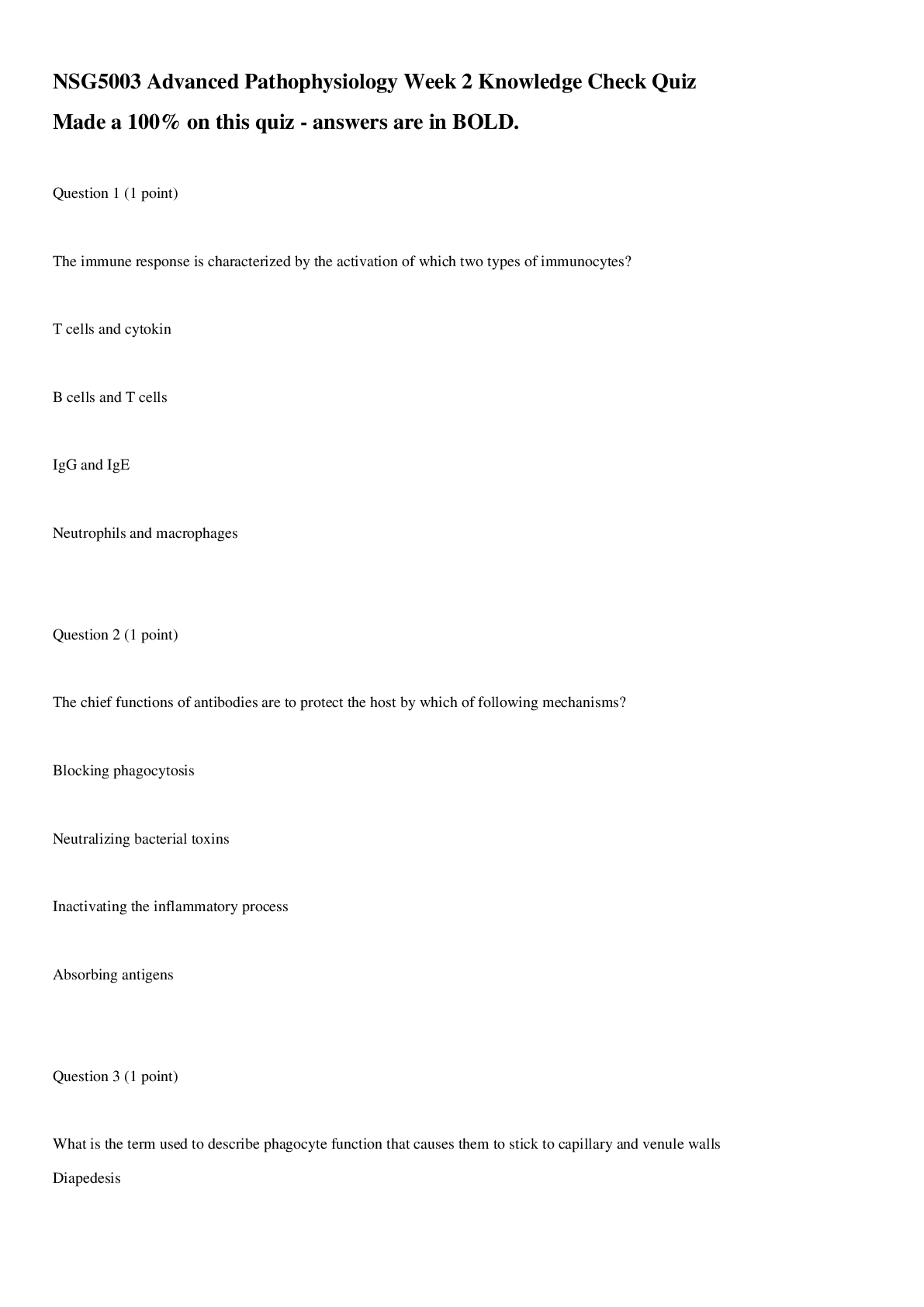
.png)
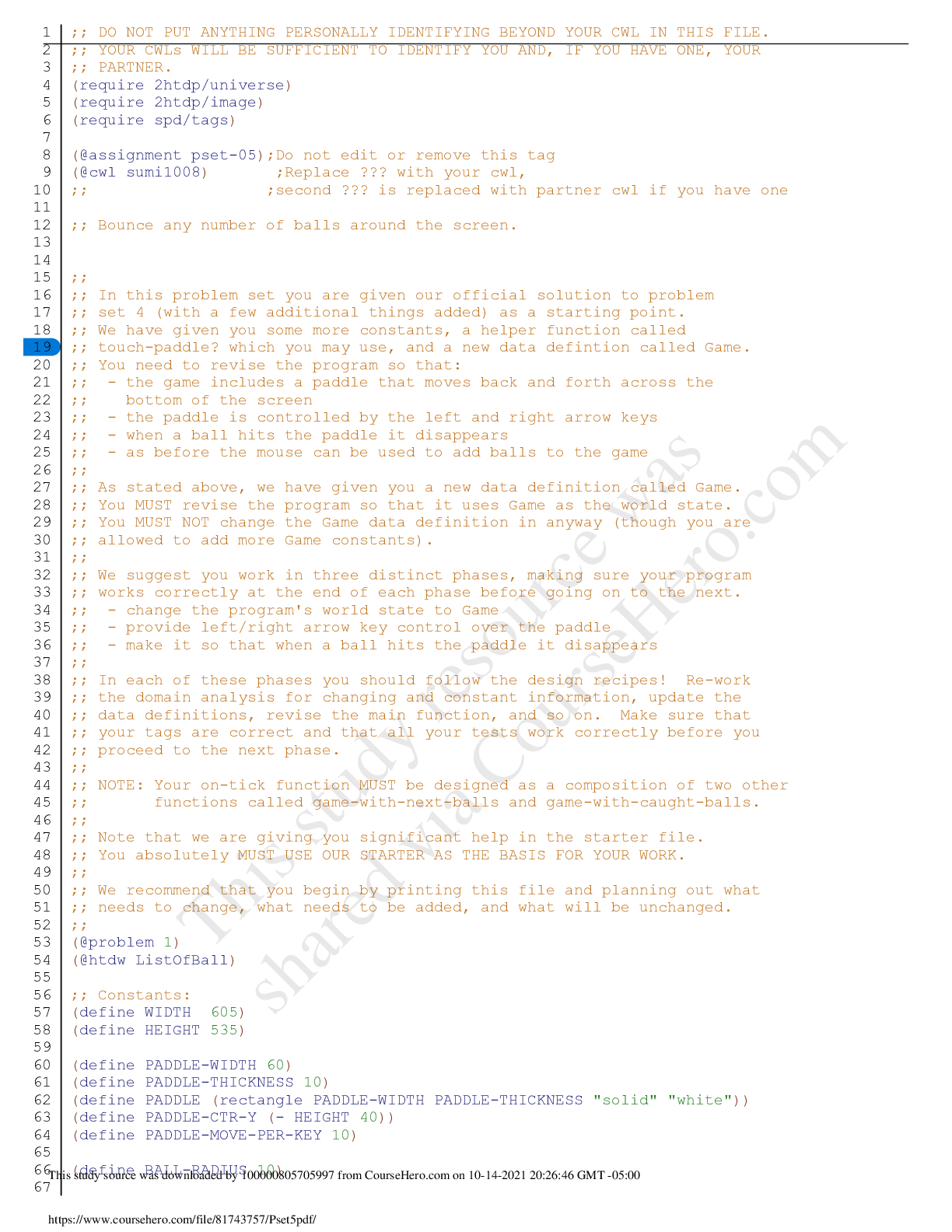



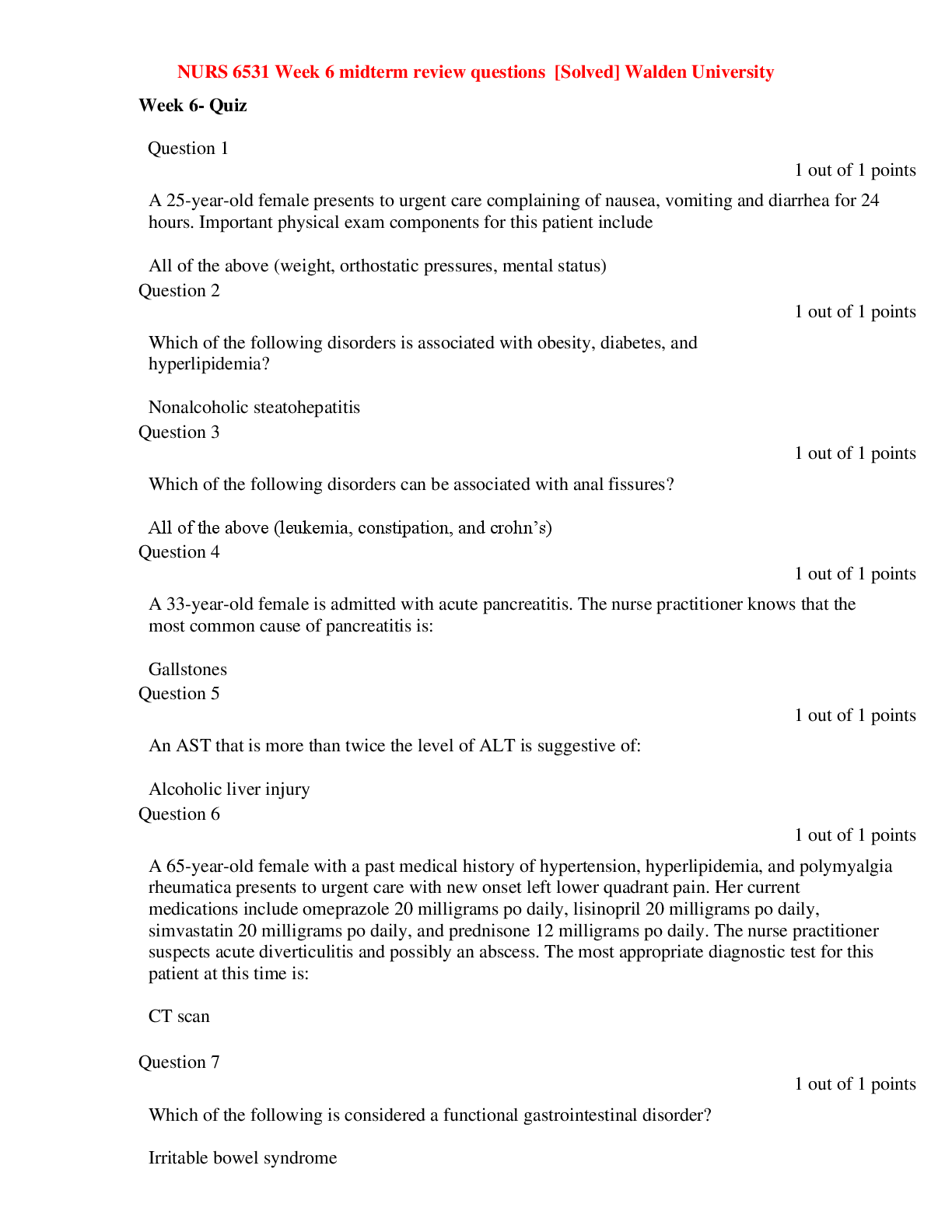

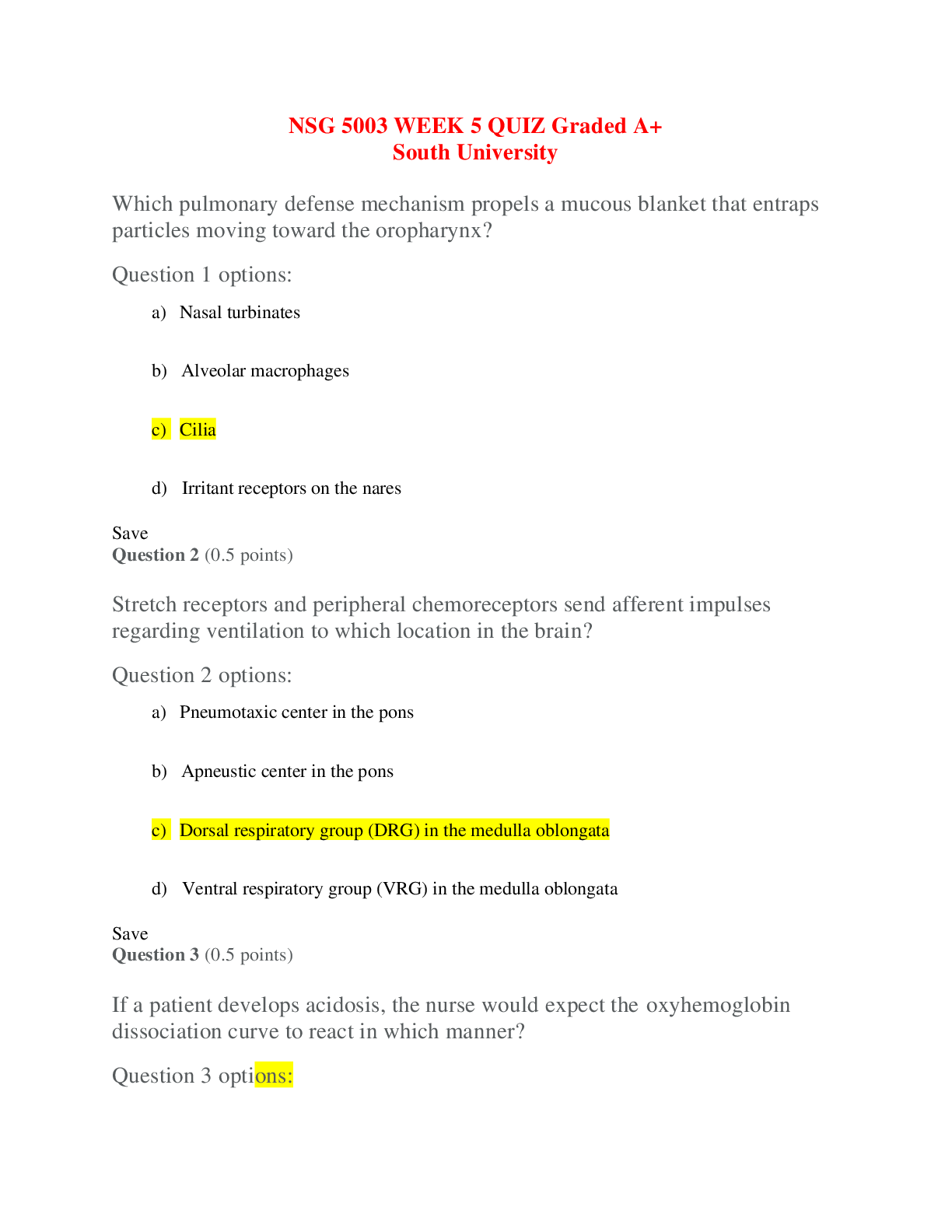
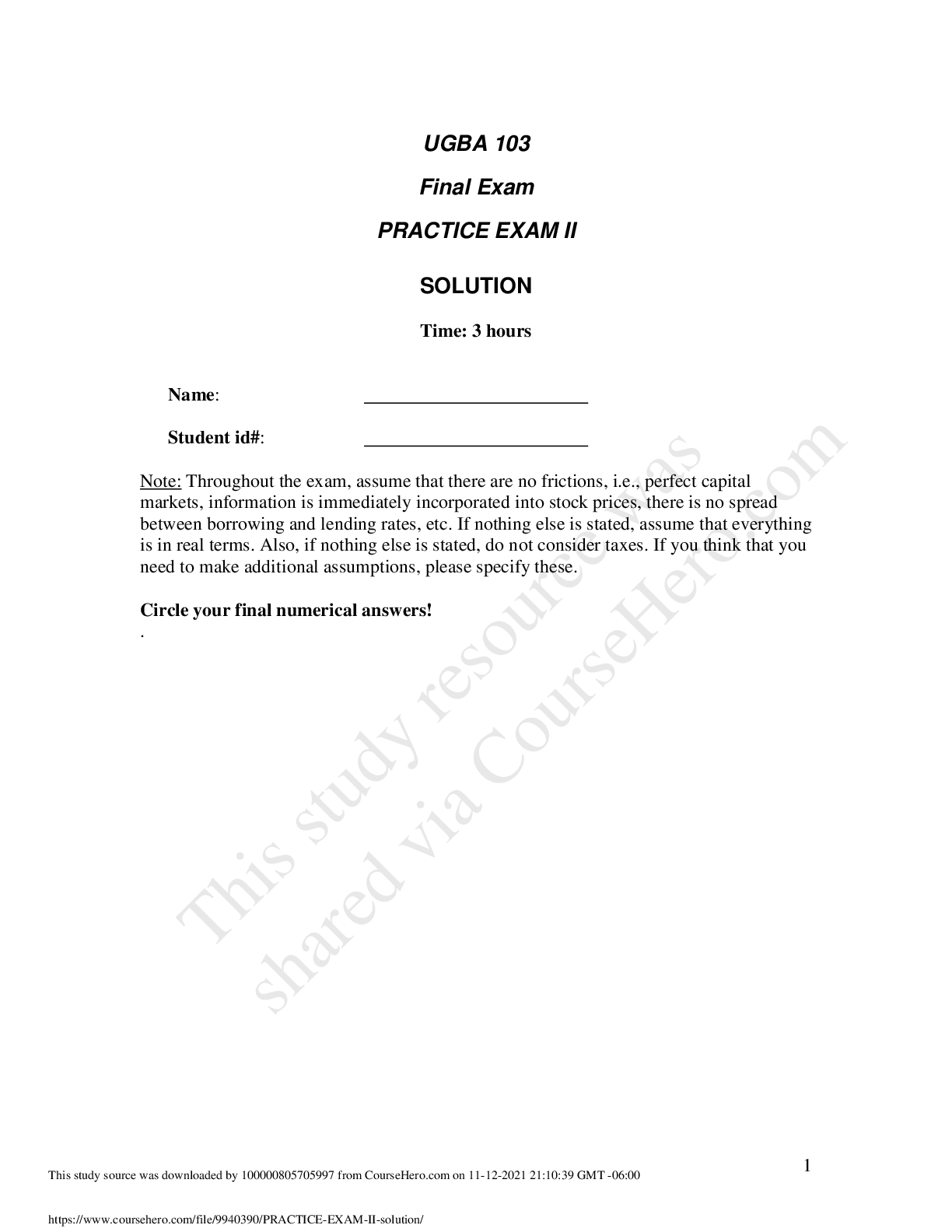


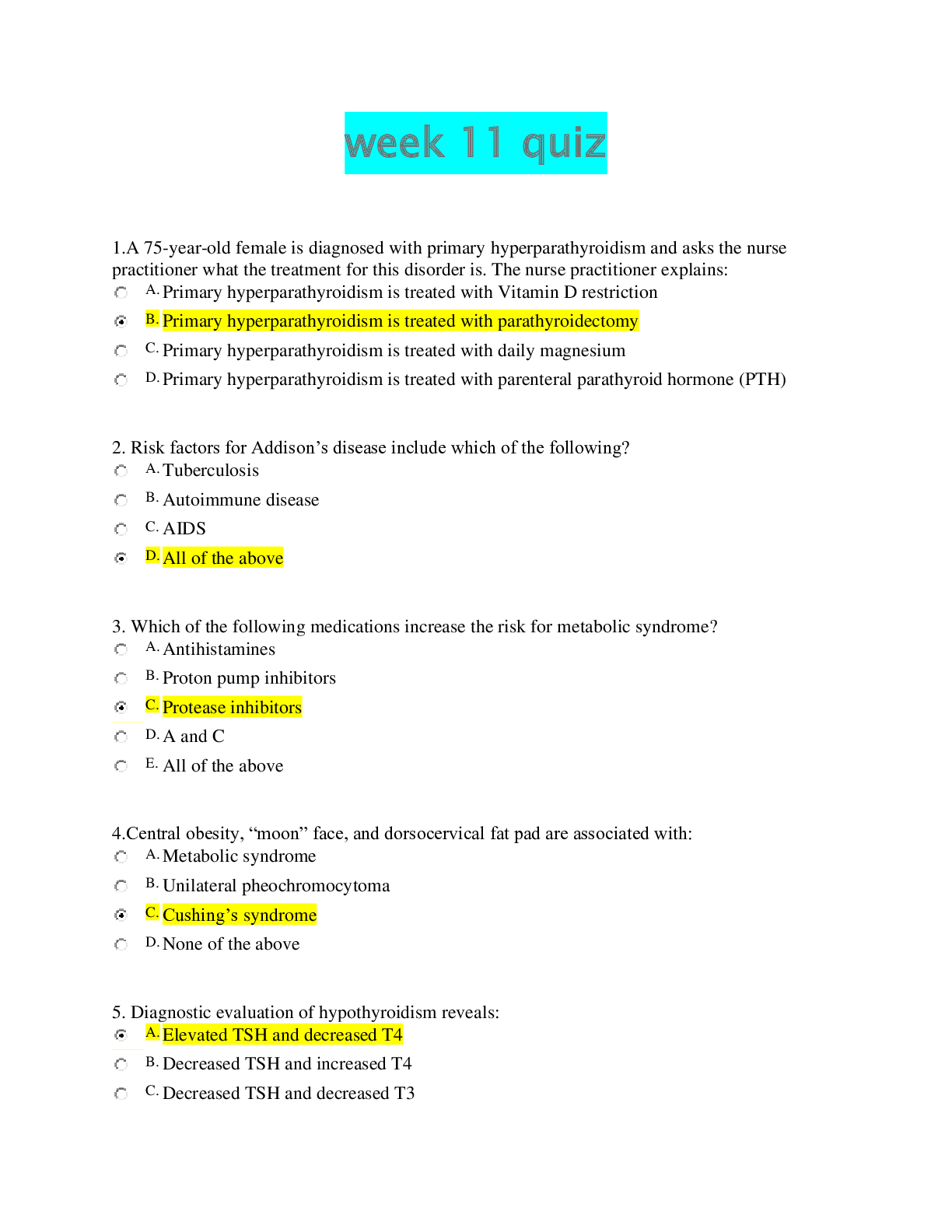


.png)
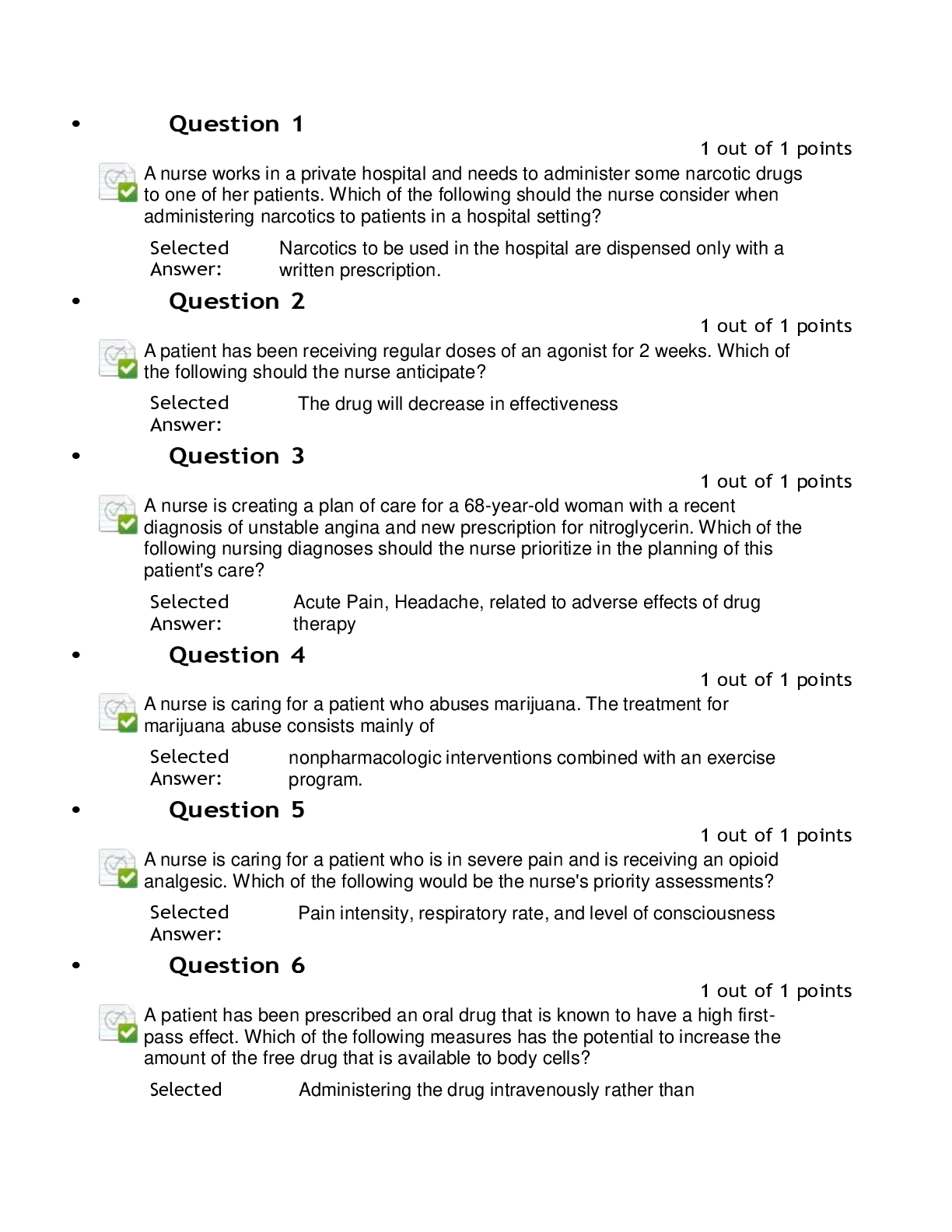
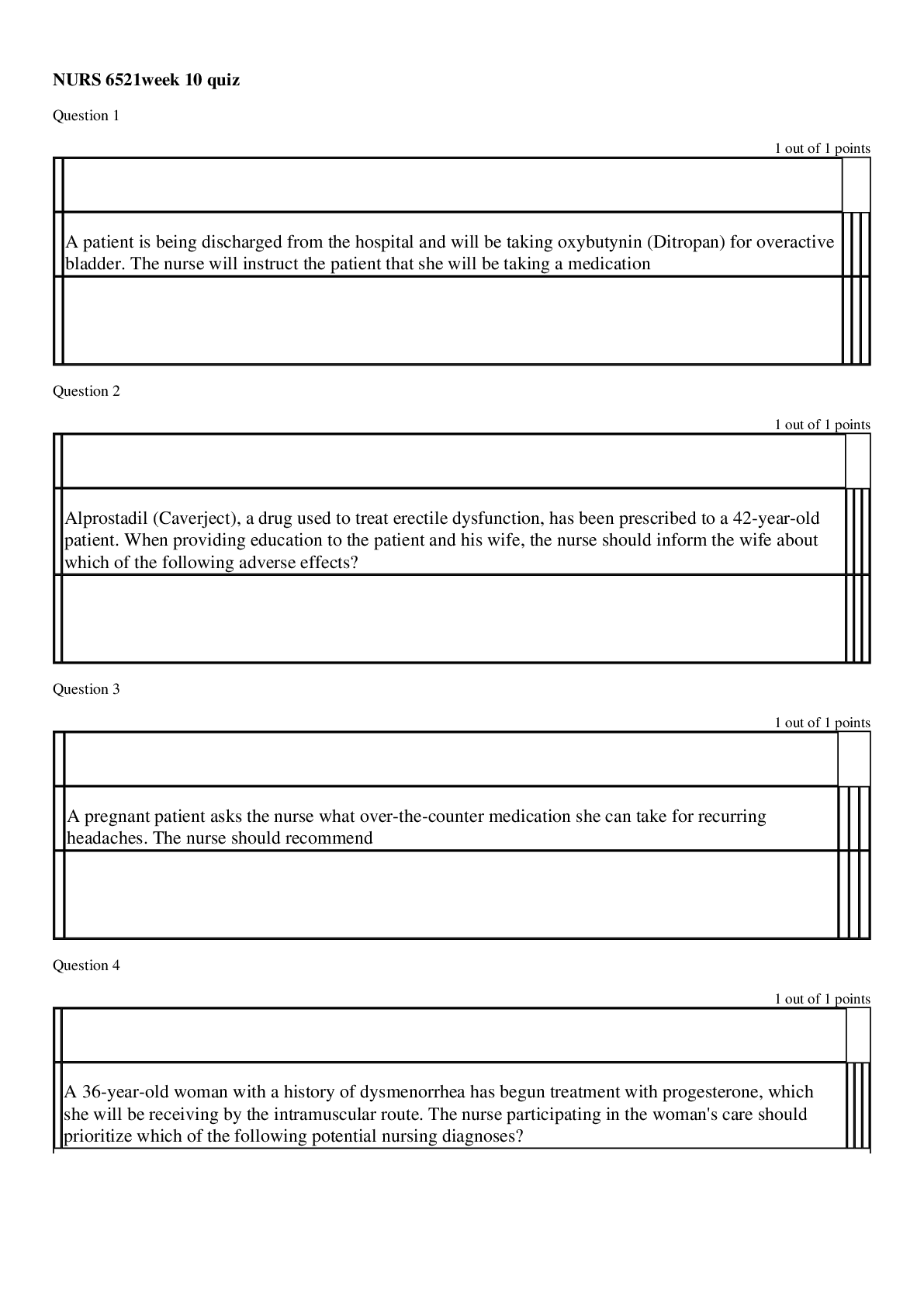
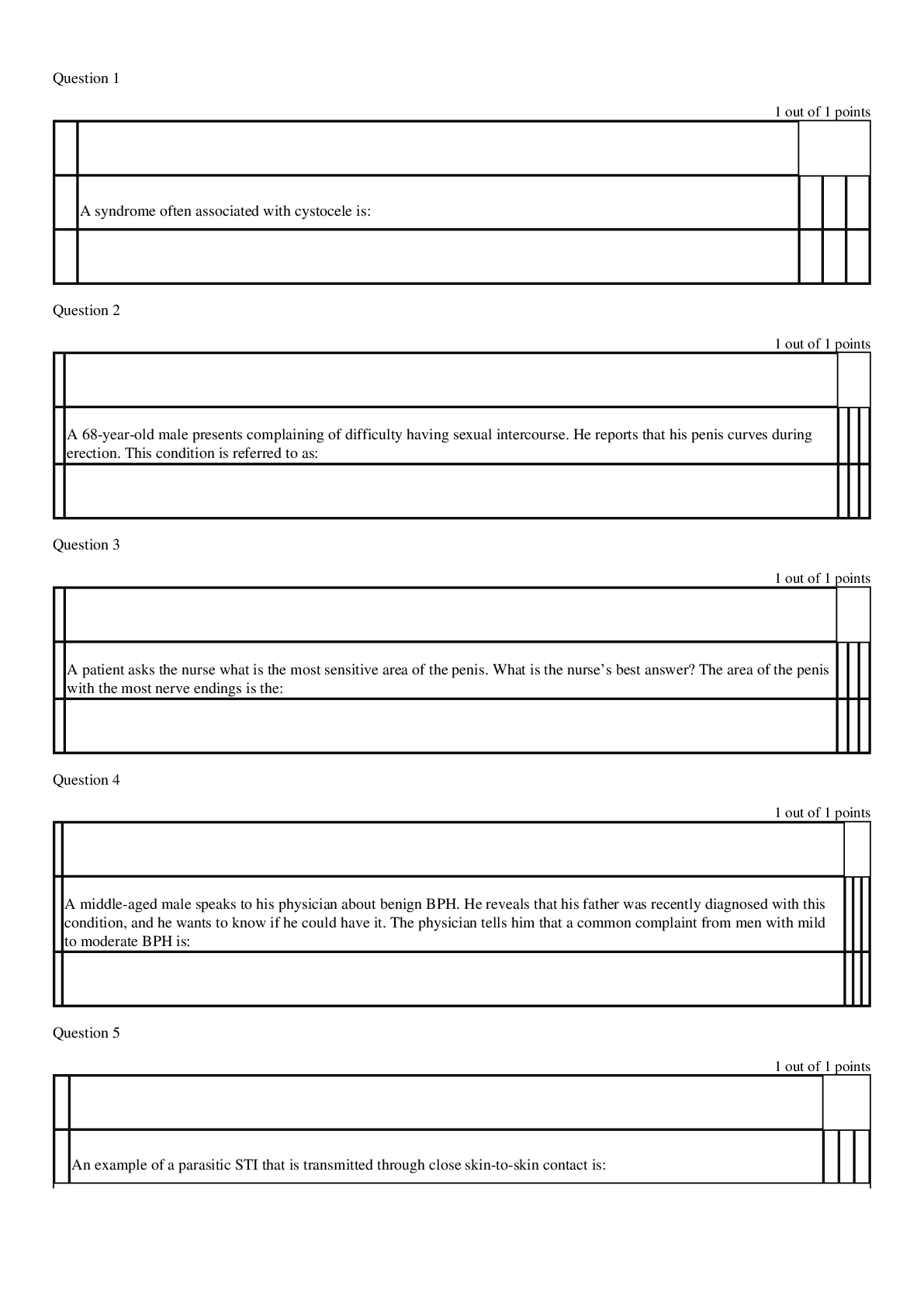
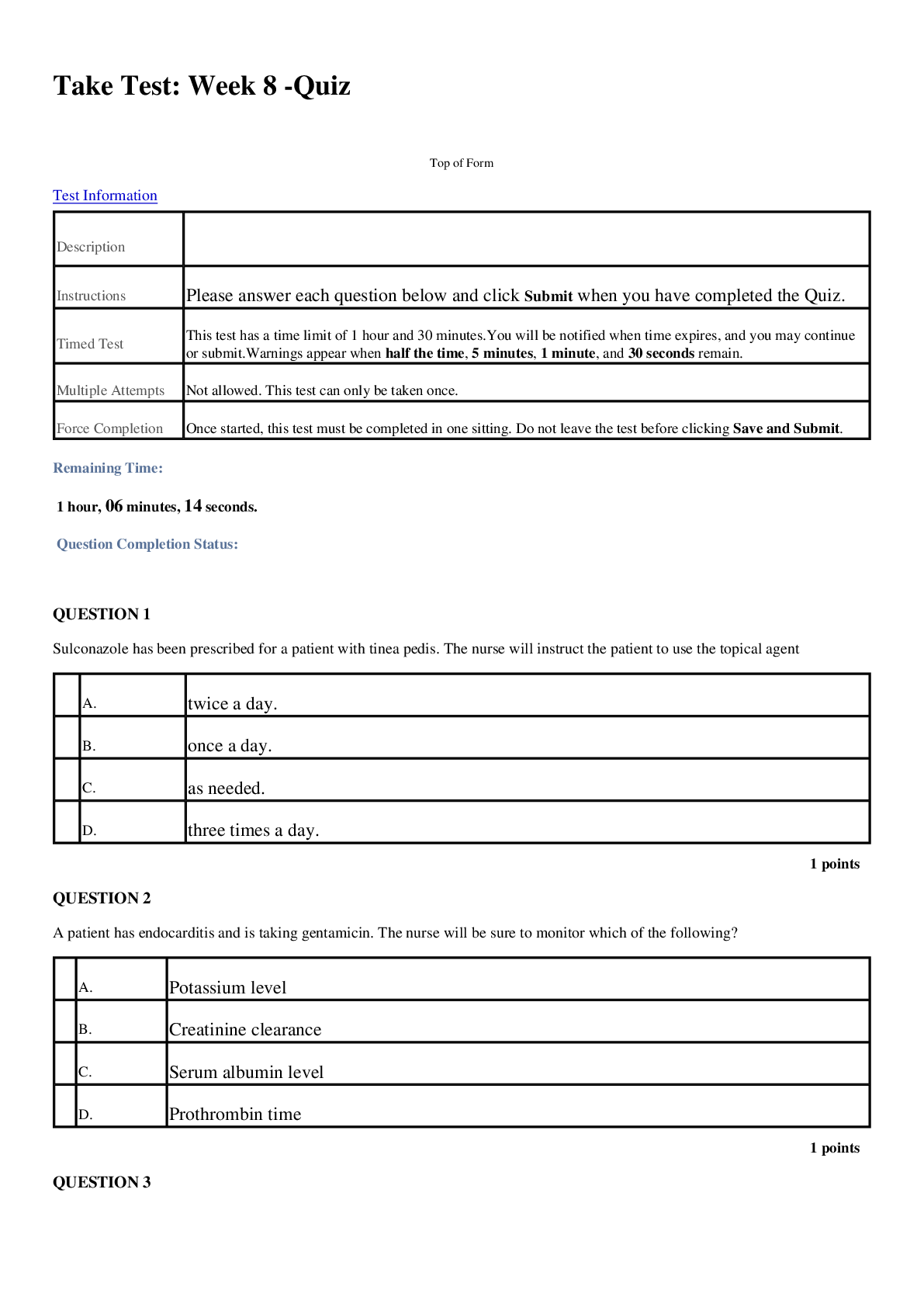

.png)

